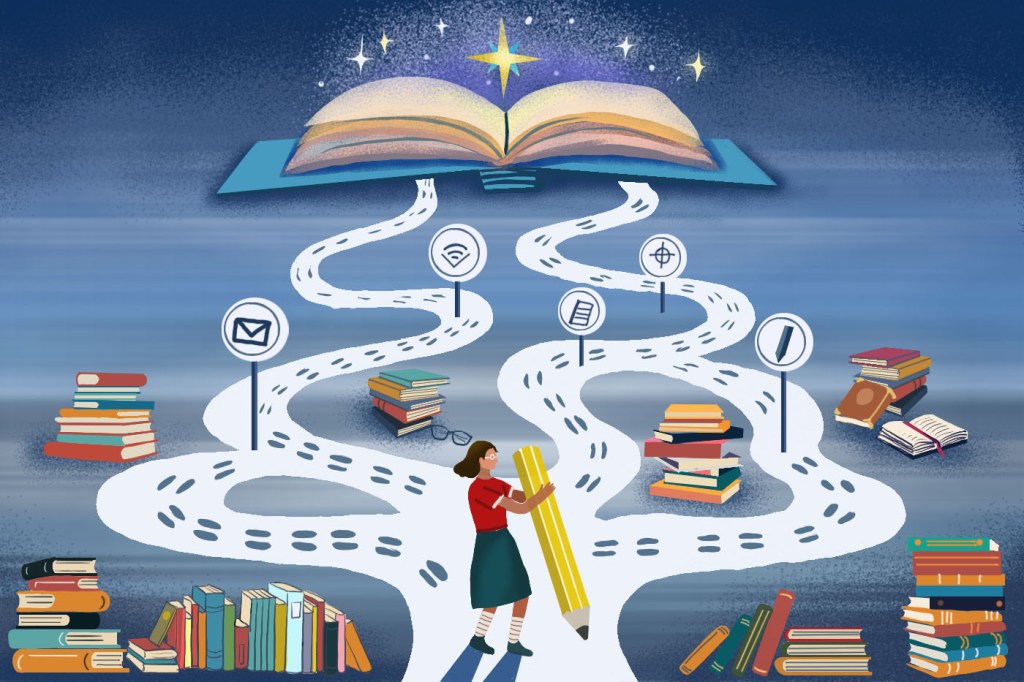Published on
From bestselling novels to unpublished manuscripts, what is the secret to literary success?
Social media, celebrity book clubs and the conglomeration of publishing houses all make publishing tricky to navigate for writers old and new.

You might think releasing 20 books — including four American Girl books — carries some weight in the publishing world. Yet, Kathryn Reiss still has four books, including a thriller for adults, in her repertoire that remain unpublished.
Reiss, an associate teaching professor in creative writing at Northeastern University’s Oakland campus, has made her name writing suspense novels for kids and teens; she published her first novel, “Time Windows,” in 1991 after writing it while on a Fulbright Scholarship in Germany. But she’s bumped up against a wall when trying to branch outside her niche.
“(Publishers) have to think they can market it,” Reiss said. “So if I want to do an adult book, or if I want to do some literary fiction that’s not a typical Kathryn Reiss suspense novel … they go ‘Well, how will we market that?’ You almost get stuck.”
Creative writing is an art, but writers face the same problem many artists do: how they can create something they like that people will also want to buy. Like any other business, book publishers want to sell a good product that they can easily market, Reiss said. But this makes it hard for writers to break out of their shell, if they can even break into the industry at all.
“For a new writer, you have to prove to them you have a very marketable book,” Reiss said. “What people don’t understand is once you’ve had a book published, it doesn’t mean you’re a shoo-in for your next book. It means your publisher will look at your next book.
“You have a one-up on someone who hasn’t published anything, but it isn’t a given. They have to think they can market it. … Publishers are really about making money. They care about their readers, but they want to sell books at the end of the day. That’s what they’re in the business to do.”
Lesser-known authors have a hard time
Public figures like Prince Harry will automatically generate intrigue and sales when they write something. Popular authors like Colleen Hoover and Emily Henry are also guaranteed hitmakers.
But debut or lesser-known authors find they have a harder time. In 2021, there were only 15 novels by debut authors on the New York Times’ list of best-selling hardcover fiction books. Of these, 10 were celebrity authors or were part of a celebrity book club and benefited from the endorsement.
The evolution of publishing has created this scenario. In his recent book, “Big Fiction,” Dan Sinykin explores how publishing has changed since the 1960s when book publishers began conglomerating and becoming more corporate. The publishers of mass market books were acquired and larger publishers took over, focusing on sales over everything else. This led to the creation of “best-selling” authors who could churn out hit after hit.
Book production increased in the 2000s when publishing shifted from manual to digital production, added Juliana Spahr, an English professor at Northeastern’s Oakland campus. Making a book became a faster and cheaper endeavor and publishing houses went from publishing a few thousand fiction titles a year to churning out tens of thousands.
Publishing more books increases the odds
Both small and large presses alike started publishing more books to increase their odds of producing a commercial hit that would offset the costs of their other works, Spahr said. At the same time, major New York publishing companies continued to gobble up smaller presses. “The Big Five” remaining companies now have a stranglehold on the publishing world.
“They’ve had control for many years over major media things like the New York Times Book Review,” Spahr said. “It’s a very different landscape. … Publishing has always been hit or miss. Nobody knows what’s going to hit. So for larger publishers, it often made sense for them to publish more titles hoping that one of them will subsidize the costs of the other titles and a bestseller. There’s no more first books. It’s really hard.”
It also makes it harder for new titles to stand out.
“The internet is a wonderful thing,” Reiss said. “But it means there’s just so much out there all the time. You can’t keep up with new books. It’s not just the 10 big publishers with their 20 new books. So much is just coming out all the time.”
There’s also the pressure to follow publishing trends. Spahr said certain topics and genres like vampire novels or romantasy (romance-fantasy) or books dealing with race have become popular at certain times and it can be hard for writers who work outside those trends.
‘I was as edgy as Jello’
Tanita Davis, who earned a master of fine arts from Northeastern’s Oakland campus and studied under Reiss, had published several books when she had a breakout hit with “Mare’s War,” a young adult historical fiction novel about two girls who find out their eccentric grandmother was in the African American battalion of the Women’s Army Corps during World War II. “Mare’s War” won Davis the Coretta Scott King Award and a nomination for the NAACP Image Award.
But Davis found her editor had a different vision for her work going forward, wanting her to write something along the lines of “The Hate U Give,” Angie Thomas’ best-selling young adult novel about a young Black girl who sees her friend killed by a police officer.
Featured Posts
“My editor at the time kept saying ‘We want you to be an edgy writer,’” said Davis, who is Black. “I was as edgy as Jello. I felt like a lot of what people were looking for was a certain type of Black character. Part of being a writer for me was wanting to express my own thoughts. Not everybody has the same experiences or can write believably about the things and there are myriad experiences of Blackness in America, (just like) there’s nearly a myriad of experiences being an American.”
Davis ended up leaving that editor and finding another who lets her write in a way that she says is more true to herself. Her recent work has been middle grade novels, with her latest, “The Science of Friendship,” coming out this month.
Davis said many agents and editors look for “comp titles.” These are other books (or other types of media) that are similar to the one being pitched; the idea is to give editors and agents an idea of how to market a new work and whether there’s a demand for it.
“The regrettable part of publishing is that it’s always looking for something that is echoing something else,” Davis said. “It’s always the next thing, and similarities are what sells and so people always say when you write your pitches, you want to say something that is like ‘Mean Girls’ meets ‘The Devil Wears Prada.’ Publishing always reacts better if they look at it and say, ‘OK, that was a really high-grossing movie, so I will feel comfortable looking over this project.’”
How to break outside existing molds
This makes it difficult, though not impossible, for writers to pitch works that break outside existing molds. Reiss’ daughter, Isabel Strychacz, followed in her mother’s footsteps and turned her thesis from her undergraduate from her time at Northeastern’s Oakland campus into her debut novel, “Starling,” a young adult novel with fantasy, sci-fi and romance elements woven together. Her second novel, “House of Thorns,” which is advertised as being “in the vein of The Haunting of Hill House” comes out this month.
But Strychacz’s experience selling her books is different from her mother’s first brushes with publishings. When Reiss published her first book in 1991, marketing was done by the publishing house and writers weren’t expected to get involved, she said. Instead, publishers would put out lists of their new titles each season. Authors would have events and signings. There’d be interviews and reviews in the local paper or on TV.
Strychacz said there’s now an understanding that writers will promote their work on social media, creating a “brand” through their posts.
“It’s almost not even mentioned because they’re just expecting that you will,” she said. “You can do as much as you want … but it’s definitely something I’ve had to think about. The reality of the industry is that like everyone wants their book to do well, so that they get another book deal and just the reality is that to do that, you almost have to be on social media to some degree and it always helps to be active in marketing your books.”
Agent system isn’t as powerful
TikTok especially has been noted for its effects on book sales. Colleen Hoover’s novel “It Ends with Us” became a New York Times bestseller and made her a household name years after it came out, thanks to users promoting it on TikTok.
In addition to facing fewer publishing options, there’s also fewer direct paths to getting published, Spahr added. People who wanted to write literary fiction would get a master of fine arts degree and their program adviser would connect them with their literary agent who would place the student’s work at a publishing house.
Now, Spahr said, the agent system isn’t as powerful and there are many writers competing for a few representatives working the market. Over the years, Reiss has taught noted writers like Nina Lacour and Aiden Thomas. But she’s struggled to place anyone she’s taught with her agent.
“Whenever I speak at conferences, people always have this question of ‘How did you break into publishing?’ That’s what everybody who wants to be a writer wants to know, as if that will be the magic key for them,” Reiss said. “Living in Germany, writing a book because I had nothing else to read, that’s not the way you’re going to break into writing. There isn’t one way.”
Erin Kayata is a Northeastern Global News reporter. Email her at e.kayata@northeastern.edu. Follow her on X/Twitter @erin_kayata.










